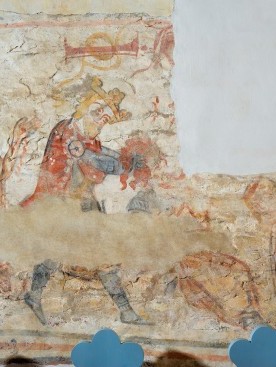The Calvinist Church – LaskodThe village was mentioned for the first time in 1283, while the church in 1483, when it was evaluated to 10 Hungarian marks. This is consistent with the value attributed in the evaluation registries of the respective period to churches having the right to perform burials, but having no towers. The church was transferred to the Calvinists probably without suffering substantial modifications before. In 1785, the villagers asked for permission to build a church using more durable materials. Probably, the previous building was in a bad shape by then. During the 18th and 19th centuries, the church was rebuilt several times. The present tower was added probably in 1863. The church’s exploration and restoration was completed in 1999. Its restoration work was inspired by the idea of making the structural elements stemming from different periods discretely, yet clearly distinguishable. This single-nave church built of bricks has a simple, rectangular nave. The narthex is located on its southern side and the three-storey tower on its western side. Three windows were cut through the western part of the southern frontispiece. A semi-circular archivolt spans all of them. During restoration, the height of the nave’s wall was increased through the addition of a glass wall divided into several parts by wooden blades. This restoration plan, thus, uses modern devices in order to help visitors understand the features of medieval architecture. It must be added, that before restoration no medieval details were visible at all. The archaeological excavations revealed that originally the sanctuary had a semi-circular layout. Moreover, it came out that the sanctuary was narrower than the nave and was separated from the latter by a projecting chancel arch. Hence, according to the results of this investigation, the original church consisted of a short, small, almost square-based nave and a narrower, semi-circular sanctuary. This floor plan resembles to a large extent to the layout of the first church built in Csengersima, probably around the middle of the 13th century. During explorations, murals have been uncovered inside the church. Of crucial importance is the cycle on the southern wall, which is dedicated to the legend of king Saint Ladislaus. Arguably, the same masters created these murals at the beginning of the 14th century, who also might have worked in Lónya, Csaroda, Gerény/Horjani and Palágykomoróc/Palad’ Komarivtsi. King Saint Ladislaus is an extremely important figure in what concerns Hungarian historical consciousness. He is one of the most widely known and famous Hungarian rulers being also salient for Hungarian ecclesiastic history, because he played a major role in consolidating Christianity. Moreover, his role and importance with regard to Hungarian religious life and feelings are also crucial, because after king Saint Stephen and his son, prince Emeric, he was the third and last Hungarian ruler to be canonised by the Catholic Church. He can also be regarded as one of the most important lay saints. The Calvinist church in Laskod preserves one of the most beautiful legends surrounding his figure. This narrative is depicted in the lower register of the southern wall from the right to the left. It consists of three scenes. The first one is the Chase, but only the figure of the Cuman warrior has been preserved. The next is the Wrestling, and the final one the Beheading. The depiction of Saint George and of the Final Judgement on the northern wall as well as Saint Paul’s figure on the southern wall might have been created at the end of the 14th century. Hence, the original church must have been built either at the end of the 13th century or rather at the beginning of the 14th century. |







